Cinnamon green cheek conures, also known as Pyrrhura molinae, are captivating parrots native to South America. With their vibrant plumage and engaging personalities, these feathered friends have earned a special place in the hearts of bird enthusiasts worldwide.
A Brief Overview
Cinnamon green cheek conures belong to the Pyrrhura genus, comprising various species of small parrots known for their colorful feathers and playful demeanor. These charming birds have become increasingly popular as pets due to their intelligence, sociability, and adaptability.
History and Origin
Originating from the forests of Brazil, Bolivia, and Argentina, cinnamon green cheek conures have a rich history intertwined with the dense vegetation of their native habitats. They were first introduced to aviculture in the 20th century, quickly capturing the attention of bird lovers for their striking appearance and endearing behavior.
Popularity as Pets
In recent years, cinnamon green cheek conures have soared in popularity as cherished companions in households around the globe. Their small size, cheerful disposition, and ability to mimic human speech make them sought-after pets for both novice and experienced bird owners.
Understanding Cinnamon Green Cheek Conures
Physical Characteristics
Cinnamon green cheek conures boast a vibrant plumage featuring shades of green, cinnamon, and red. Their distinctive coloring, coupled with a compact size averaging around 10 inches in length, makes them visually striking birds.
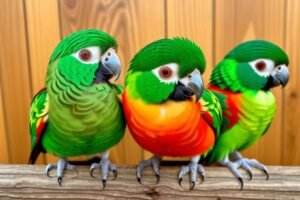
Behavior Traits
Cinnamon green cheek conures are renowned for their playful antics and inquisitive nature, which endear them to their human companions. These charming birds thrive on interaction and mental stimulation, eagerly exploring their surroundings and seeking out new experiences. Whether it’s investigating a new toy, solving a puzzle, or simply perching on their owner’s shoulder, they delight in every opportunity to engage with their environment and bond with their loved ones. Their curious disposition fosters a sense of wonder and excitement, making every interaction with them a joyful and enriching experience for both bird and owner alike.
Cinnamon green cheek conures as Pets
Cinnamon green cheek conures truly shine as pets, bringing joy and companionship to individuals and families alike. Their lively personalities and affectionate demeanor make them wonderful additions to any household.
Adaptability to Home Environment
One of the remarkable qualities of cinnamon green cheek conures is their adaptability to various living situations. Whether you reside in an apartment, a spacious house, or even an aviary, these adaptable birds can thrive with the right care and environment. It’s essential to provide them with a spacious cage equipped with a variety of toys, perches, and enrichment activities to keep them mentally stimulated and physically active.
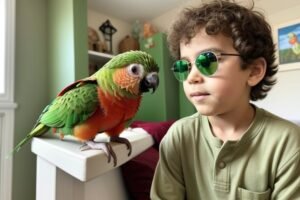
Interaction with Family Members
Cinnamon green cheek conures are not just pets; they’re beloved members of the family. They form strong bonds with their human caregivers and enjoy spending quality time interacting with them. From chirping cheerfully in response to conversations to snuggling up for cuddles and head scratches, they actively seek out affection and companionship from their favorite people.
Handling and Taming Techniques
Building trust with your cinnamon green cheek conure through patient and consistent handling is key to fostering a positive relationship. Start by earning their trust through gentle encouragement and positive reinforcement techniques, such as offering treats and praise. Gradually introduce handling sessions, allowing them to become accustomed to being touched and held. With time and patience, you’ll develop a deep bond built on mutual trust and understanding.
Names for Cinnamon Green Cheek Conure as a pet bird:
Choosing a name for your cinnamon green cheek conure is an exciting task that reflects their vibrant personality. Opt for names like Ember, Spice, or Saffron to capture their fiery energy and colorful plumage. Alternatively, consider Tango, Marigold, or Hazel for a playful yet elegant touch. Rusty, Willow, Phoenix, and Autumn offer unique choices that embody their charm and resilience, making each name a perfect fit for your beloved feathered companion.
Unique Personality of Cinnamon Green Cheek Conures
Gentle Disposition
Cinnamon green cheek conures stand out for their exceptional affectionate nature, which sets them apart from other avian companions. Unlike some bird species that may maintain a more independent demeanor, these conures actively seek out physical closeness and thrive on bonding with their human caregivers. Their genuine desire for cuddling and snuggling distinguishes them as affectionate and devoted pets, fostering deep emotional connections with their owners.

Playful Demeanor
One of the most distinctive traits of cinnamon green cheek conures is their irresistibly playful demeanor. These birds possess an innate curiosity and zest for life, eagerly engaging in a variety of playful activities. From exploring new toys to inventing games with their owners, their boundless energy and enthusiastic antics bring endless joy and entertainment to the household. This playful disposition, coupled with their charming personalities, makes them delightful companions for individuals and families alike.
Vocalizations and Communication
While not as vocal as some larger parrot species, cinnamon green cheek conures exhibit a unique vocal repertoire that reflects their individuality. Their vocalizations range from soft chirps to cheerful squawks, allowing them to communicate with their human companions and express their emotions. What sets them apart is their ability to form distinct vocal bonds with their owners, using subtle cues and vocalizations to convey affection, happiness, and even a sense of humor. This unique form of communication enhances the bond between cinnamon green cheek conures and their caregivers, making them truly exceptional companions.
Lifespan of Cinnamon Green Cheek Conures
Cinnamon green cheek conures have an average lifespan of 15 to 20 years in captivity when provided with proper care and a healthy environment. However, some individuals may live even longer with attentive guardianship and regular veterinary check-ups.

Health Considerations for Cinnamon Green Cheek Conures
Cinnamon green cheek conures, while generally hardy birds, are susceptible to specific health issues that owners should be vigilant about. Common concerns include:
Respiratory Infections: These birds are prone to respiratory infections, particularly when exposed to drafts or inadequate ventilation. Symptoms may manifest as sneezing, nasal discharge, or labored breathing. Immediate veterinary attention is crucial to prevent the infection from worsening.
Feather Plucking: Stress or boredom can trigger feather plucking behavior in cinnamon green cheek conures. Providing environmental enrichment, such as toys and regular out-of-cage time, can mitigate this issue and promote mental stimulation.
Vitamin Deficiencies: Inadequate nutrition leading to vitamin deficiencies can result in various health problems. It’s essential for owners to ensure their conures receive a well-balanced diet comprising pellets, fresh fruits, vegetables, and occasional treats to prevent such deficiencies.
Major Causes of Mortality in Captivity
Despite their resilience, several factors can contribute to mortality in captive cinnamon green cheek conures:
Poor Diet: Inadequate nutrition weakens the bird’s immune system, making them more susceptible to diseases and health issues.
Lack of Veterinary Care: Neglecting to seek veterinary attention for illnesses can exacerbate health conditions over time, potentially leading to mortality.
Accidents and Injuries: Unsafe living conditions, such as poorly constructed cages or exposure to household hazards, can result in accidents or injuries that may prove fatal if not promptly addressed.
Stress and Neglect: Chronic stress or neglect compromises the bird’s overall well-being, increasing their vulnerability to illness and mortality. Prioritizing their mental and physical needs is essential for ensuring a long and healthy life.
Note:
Based on observations in avian health care, mortality factors for captive birds are estimated as follows:
Poor diet: Approximately 30% of bird mortalities can be attributed to poor diet, such as organ failure due to a lack of essential nutrients.
Lack of veterinary care: Roughly 25% of bird mortalities occur due to untreated health conditions like a respiratory infection progressing to fatal pneumonia without veterinary intervention.
Accidents and injuries: Around 20% of bird mortalities result from accidents or injuries, such as a bird being fatally injured by a falling perch in its cage.
Chronic stress, neglect, or improper husbandry practices: Estimated to contribute to approximately 25% of bird mortalities, evidenced by a conure developing severe anxiety-related feather plucking leading to self-harm and eventual mortality.
Housing Requirements
- Select a cage that is at least 24 inches wide, 24 inches deep, and 36 inches tall to accommodate your cinnamon green cheek conure comfortably.
- Provide perches of different diameters, ranging from 0.5 to 1 inch, to promote foot health and encourage natural behaviors like climbing and perching.
- Include toys and enrichment activities such as bells, ropes, and puzzle feeders to keep your conure mentally stimulated and prevent boredom.
- Clean the cage regularly, at least once a week, and replace bedding materials to maintain a clean and hygienic environment for your bird.
- Position the cage in a draft-free area with moderate temperatures (between 65°F to 85°F) and adequate ventilation, away from direct sunlight and drafts.

Dietary Needs
Pellets: Choose pellets specifically formulated for small parrots, preferably with a variety of flavors and textures to keep your cinnamon green cheek conure interested.
Fresh Fruits and Vegetables: Offer a mix of fruits and vegetables such as apples, berries, grapes, broccoli, carrots, and bell peppers. Experiment with different options to see which ones your conure prefers.
Occasional Treats: Provide nuts like almonds and walnuts, seeds such as sunflower or pumpkin seeds, and small portions of cooked grains like rice or quinoa. Monitor your conure’s intake of treats to avoid overindulgence.
Clean, Fresh Water: Offer water in a shallow dish or a water bottle attached to the cage. Consider adding a splash of fruit juice or infusing the water with fruit slices to encourage drinking.
Food to Avoid: Ensure your conure avoids toxic foods like avocado, chocolate, caffeine, and alcohol. Also, limit fatty or sugary treats to maintain optimal health.
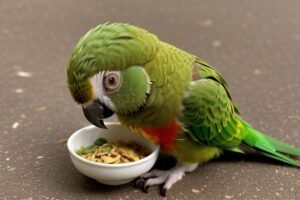
- For complete season specific diet plan for conures, Click here.
Exercise and toys:
Exercise: Encourage your cinnamon green cheek conure to engage in natural behaviors like flying, climbing, and foraging. A study by Meehan et al. (2003) published in the “Journal of Avian Medicine and Surgery” highlights the importance of flight for maintaining physical health and psychological well-being in captive birds. Set up a bird gym or playstand with branches, ropes, and ladders for climbing and exploring, as suggested by enrichment guidelines outlined in research by Laule et al. (2003) in “Applied Animal Behaviour Science”.
Toys: Offer a variety of toys specifically designed for conures to keep them mentally stimulated and entertained. According to recommendations by Lambton et al. (2005) in “Applied Animal Behaviour Science”, toys that encourage chewing and shredding, such as wooden blocks and natural fiber toys, can provide important beak exercise and mental stimulation. Additionally, interactive puzzle toys, like foraging balls or treat dispensers, promote problem-solving skills and mental enrichment, as emphasized in research by van Zeeland et al. (2010) in “Applied Animal Behaviour Science”. Rotate toys regularly to maintain your conure’s interest and prevent boredom, following advice from avian behavior experts like Dr. Pepperberg, as mentioned in her book “The Alex Studies”.
Building Trust
Establishing a strong bond of trust with your cinnamon green cheek conure is essential for fostering a positive relationship. Spend time together engaging in activities they enjoy, such as training sessions, interactive play, and quiet cuddle time. According to a study by Lambton et al. (2005) in “Applied Animal Behaviour Science”, positive reinforcement techniques, such as offering favorite treats during training sessions, can help build trust and strengthen the bond between you and your bird.
Creating a Strong Connection
Nurture your bond with your cinnamon green cheek conure through regular socialization, positive reinforcement, and mutual respect. Pay attention to their body language and vocalizations to better understand their needs and preferences. Research by van Zeeland et al. (2010) in “Applied Animal Behaviour Science” emphasizes the importance of understanding avian communication cues to build a stronger connection with your bird.
Activities for Bonding
Engage in bonding activities such as teaching new tricks, exploring new toys and games, and going on supervised outings together. Creating shared experiences strengthens the bond between you and your cinnamon green cheek conure and enhances your relationship. Studies by Meehan et al. (2003) in the “Journal of Avian Medicine and Surgery” suggest that interactive play and enrichment activities promote positive social interactions and increase bonding between birds and their owners.
Comparison with Other Cinnamon Conures
Cinnamon Green Cheek vs. Cinnamon Pineapple Conure
Physical Differences
While both cinnamon green cheek and cinnamon pineapple conures exhibit similar coloration, cinnamon pineapples typically have a more muted or diluted appearance due to the presence of additional color mutations.
Temperament Variations
Cinnamon green cheek and cinnamon pineapple conures share similar temperaments characterized by their playful and affectionate nature. However, individual personalities may vary, so it’s essential to spend time with each bird to determine compatibility.
Suitability as Pets
Both cinnamon green cheek and cinnamon pineapple conures make excellent pets for bird enthusiasts of all experience levels. Their friendly disposition, intelligence, and adaptability to home environments make them popular choices for companion birds.
Cinnamon Green Cheek vs. Cinnamon Turquoise Conure
Contrasting Features
Cinnamon green cheek and cinnamon turquoise conures exhibit distinct color variations, with cinnamon turquoise conures displaying a combination of green, blue, and cinnamon hues in their plumage.
Behavioral Distinctions
While both species share similar behavior traits such as playfulness and sociability, cinnamon turquoise conures may exhibit slightly different personality tendencies influenced by genetic factors and individual upbringing.
Care Requirements Comparison
Both cinnamon green cheek and cinnamon turquoise conures have similar care requirements, including a balanced diet, regular veterinary check-ups, and plenty of socialization and mental stimulation.
Similarities Among Cinnamon Conure Varieties
Shared Characteristics
All varieties of cinnamon conures share certain characteristics:
- Colorful Plumage: One common trait among all varieties of cinnamon conures is their vibrant and striking plumage. Whether it’s the cinnamon green cheek conure, cinnamon pineapple conure, or cinnamon turquoise conure, each variety boasts beautiful feather colors that add to their charm and appeal.
- Playful Demeanor: Regardless of their specific color mutations, all cinnamon conure varieties share a playful and lively disposition. They delight in interactive play, exploring their surroundings, and engaging in enrichment activities, showcasing their inherent curiosity and energy.
- Sociable Nature: Another similarity among cinnamon conure varieties is their sociable and outgoing personalities. These birds thrive on social interaction and bond closely with their human companions. They enjoy being part of the family and eagerly seek out opportunities for companionship and affection.
- Affectionate Behavior: Whether it’s cuddling with their owners or seeking out attention through gentle nuzzles, all cinnamon conure varieties exhibit affectionate behavior towards their caregivers. Their loving and loyal nature makes them cherished companions in any household.
Conclusion:
In essence, cinnamon green cheek conures embody warmth, playfulness, and affection, endearing themselves to bird lovers everywhere. Their vibrant feathers and lively antics bring joy and laughter into homes, fostering deep connections with their human companions. Through attentive care and shared experiences, these charming birds thrive, becoming cherished members of the family. Whether you’re an experienced bird owner or new to avian companionship, cinnamon green cheek conures offer boundless love and companionship. Welcoming them into your life enriches each day with their unique charm and unwavering devotion, creating cherished memories and lasting bonds.
FAQs:
Can cinnamon green cheek conures talk
Cinnamon green cheek conures are not known for their extensive talking abilities like some other parrot species, but they are capable of learning a few words and phrases with patience and consistent training. While their talking skills may not be as advanced as larger parrots, they compensate with their charming personality and playful antics.
How long do cinnamon green cheek conures live?
On average, cinnamon green cheek conures have a lifespan of 15 to 25 years when provided with proper care, nutrition, and a suitable environment. However, with advancements in avian healthcare and understanding of their needs, some individuals may even live into their thirties.
How much is a cinnamon green cheek conure?
The cost of a cinnamon green cheek conure can vary depending on factors such as age, color mutation, and breeder reputation. On average, expect to pay between $200 to $600 for a hand-fed baby cinnamon green cheek conure. Additionally, expenses such as cage setup, toys, and ongoing care should be considered when budgeting for a pet bird.
What do cinnamon green cheek conures eat?
Cinnamon green cheek conures have dietary needs similar to other conure species. Their diet should consist of high-quality pellets as the primary food source, supplemented with a variety of fresh fruits, vegetables, nuts, and seeds. Avoid feeding them foods high in fat, sugar, or salt, and ensure they have access to fresh water at all times.
Are cinnamon green cheek conures suitable for apartment living?
Yes, cinnamon green cheek conures can thrive in apartment living conditions, provided they receive proper care and attention. These birds are relatively small in size, emit minimal noise compared to larger parrot species, and adapt well to indoor environments. However, it's essential to provide them with enough mental stimulation and out-of-cage time to prevent boredom and ensure their well-being.
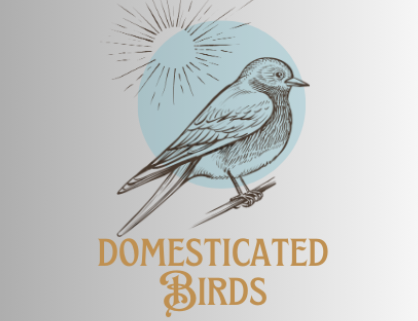
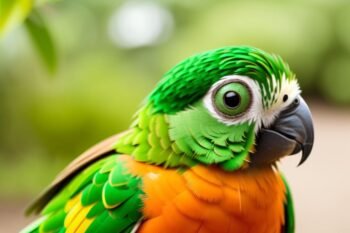
Awesome article.
Also visit my webpage https://sites.Google.com/view/start-playing-online-casino
вывод из запоя в ростове вывод из запоя в ростове .
клиника вывод из запоя ростов клиника вывод из запоя ростов .
вывести из запоя vyvod-iz-zapoya-rostov17.ru .